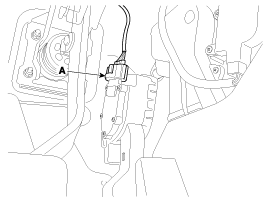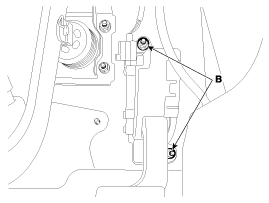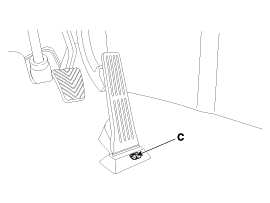Hyundai Tucson: Engine Control System / Accelerator Position Sensor (APS) Repair procedures
Hyundai Tucson (LM) 2010-2015 Service Manual / Engine Control / Fuel System / Engine Control System / Accelerator Position Sensor (APS) Repair procedures
| Inspection |
| 1. |
Connect the GDS on the Data Link Connector (DLC). |
| 2. |
Turn the ignition switch ON. |
| 3. |
Measure the output voltage of the APS 1 and 2 at C.T and W.O.T.
|
| Removal |
| 1. |
Turn the ignition switch OFF and disconnect the negative (-) battery cable. |
| 2. |
Disconnect the accelerator position sensor connector (A).
|
| 3. |
Remove the installation nuts (B), the bolt (C) and then remove the accelerator pedal module.
|
| Installation |
| 1. |
Install in the reverse order of removal.
|
 Accelerator Position Sensor (APS) Schematic Diagrams
Accelerator Position Sensor (APS) Schematic Diagrams
Circuit Diagram
(M/T)
(A/T)
...
 Fuel Tank Pressure Sensor (FTPS) Description and Operation
Fuel Tank Pressure Sensor (FTPS) Description and Operation
Description
Fuel Tank Pressure Sensor (FTPS) is a component of the
evaporative emission control system and is installed on the fuel tank,
the fuel pump, or the canister. It checks the purge con ...
Other information:
Hyundai Tucson (LM) 2010-2015 Service Manual: Repair procedures
Fuel Pressure Test (Low pressure system)
1.
Release the residual pressure in fuel line.
(Refer to Fuel Delivery System - "Release Residual Pressure in Fuel Line")
When removing the fuel pump relay, a Diagnostic Trouble Code
(DTC) may occur. Delete the code with the GDS ...
Hyundai Tucson (LM) 2010-2015 Owners Manual: Hill-Start Assist Control (HAC)
The Hill-Start Assist Control (HAC) prevents the vehicle from rolling backwards
when starting a vehicle from a stop on a hill. The system operates the brakes automatically
for approximately 2 seconds and releases the brake when the accelerator pedal is
depressed or after 2 seconds.
WARNING
A ...
© 2010-2025 www.htmanual.net



